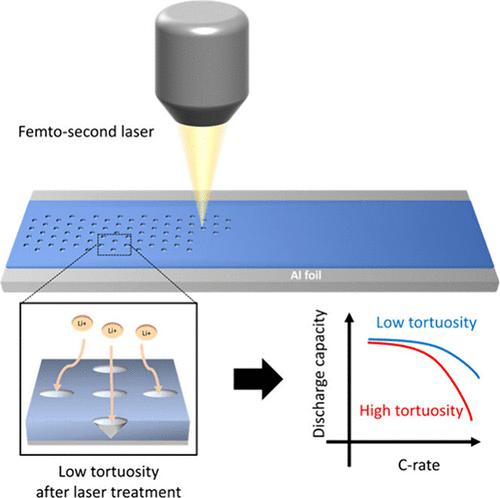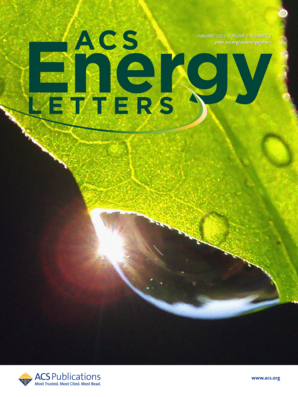Overcoming the Energy vs Power Dilemma in Commercial Li-Ion Batteries via Sparse Channel Engineering
IF 19.3
1区 材料科学
Q1 CHEMISTRY, PHYSICAL
引用次数: 0
Abstract
Improvements in both the power and energy density of lithium-ion batteries (LIBs) will enable longer driving distances and shorter charging times for electric vehicles (EVs). The use of thicker and denser electrodes reduces LIB manufacturing costs and increases energy density characteristics at the expense of much slower Li-ion diffusion, higher ionic resistance, reduced charging rate, and lower stability. Contrary to common intuition, we unexpectedly discovered that removing a tiny amount of material (<0.4 vol %) from the commercial electrodes in the form of sparsely patterned conical pores greatly improves LIB rate performance. Our research revealed that upon commercial production of high areal capacity electrodes, a very dense layer forms on the electrode surface, which serves as a bottleneck for Li-ion transport. The formation of sparse conical pore channels overcomes such a limitation, and the facilitated ion transport delivers much higher power without reduction in the practically attainable energy. Diffusion and finite element method-based simulations provide deep insights into the fundamentals of ion transport in such electrode designs and corroborate the experimental findings. The reported insights provide a major thrust to redesigning automotive LIB electrodes to produce cheaper, longer driving range EVs that retain fast charging capability.

通过稀疏通道工程克服商用锂离子电池的能量与功率难题
锂离子电池(LIB)功率和能量密度的提高将使电动汽车(EV)的行驶距离更长,充电时间更短。使用更厚更密的电极可降低锂离子电池的制造成本,提高能量密度特性,但代价是锂离子扩散速度更慢、离子电阻更高、充电速度更慢、稳定性更差。与通常的直觉相反,我们意外地发现,以稀疏图案化锥形孔的形式从商用电极中去除极少量的材料(0.4 vol %),就能大大提高锂离子电池的速率性能。我们的研究发现,在商业化生产高电容电极时,电极表面会形成一层非常致密的层,成为锂离子传输的瓶颈。稀疏锥形孔道的形成克服了这一限制,促进了离子传输,从而在不降低实际能量的情况下大大提高了功率。基于扩散和有限元法的模拟深入揭示了这种电极设计中离子传输的基本原理,并证实了实验结果。报告中的见解为重新设计汽车锂离子电池电极提供了重要的推动力,从而生产出更便宜、行驶里程更长且保持快速充电能力的电动汽车。
本文章由计算机程序翻译,如有差异,请以英文原文为准。
求助全文
约1分钟内获得全文
求助全文
来源期刊

ACS Energy Letters
Energy-Renewable Energy, Sustainability and the Environment
CiteScore
31.20
自引率
5.00%
发文量
469
审稿时长
1 months
期刊介绍:
ACS Energy Letters is a monthly journal that publishes papers reporting new scientific advances in energy research. The journal focuses on topics that are of interest to scientists working in the fundamental and applied sciences. Rapid publication is a central criterion for acceptance, and the journal is known for its quick publication times, with an average of 4-6 weeks from submission to web publication in As Soon As Publishable format.
ACS Energy Letters is ranked as the number one journal in the Web of Science Electrochemistry category. It also ranks within the top 10 journals for Physical Chemistry, Energy & Fuels, and Nanoscience & Nanotechnology.
The journal offers several types of articles, including Letters, Energy Express, Perspectives, Reviews, Editorials, Viewpoints and Energy Focus. Additionally, authors have the option to submit videos that summarize or support the information presented in a Perspective or Review article, which can be highlighted on the journal's website. ACS Energy Letters is abstracted and indexed in Chemical Abstracts Service/SciFinder, EBSCO-summon, PubMed, Web of Science, Scopus and Portico.
 求助内容:
求助内容: 应助结果提醒方式:
应助结果提醒方式:


